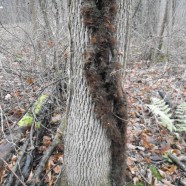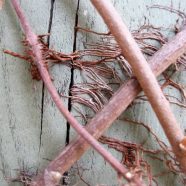Poison Ivy: Hairy Vine
There are almost as many ways to climb trees as there are species of vines. Grapevines have curly tendrils that grab branches, while Virginia creepers use little suction-cups. Asian bittersweet corkscrews its way round and round the tree trunk. But poison ivy’s method of ascent is unique. Poison ivy gets to the top by growing thread-like rootlets all along the length of its stems. At first the rootlets appear as little patches that look like tufts of fuzzy hair. The furry roots secrete a glue-like substance which virtually cements the vine to tree or wall. As the main stem ages, more and...
Read MoreWild Grape: Clinging Vine
There’s something shady about vines. Look at the names we give them—creepers, stranglers, parasites—they’re the bad guys of the plant world. To those of us raised in a strict Puritan work ethic, there’s something morally dubious about a plant that can’t stand on its own two feet, so to speak. Why can’t vines support themselves and not go draping themselves all over other plants? A “clinging vine” is the very definition of weakness. But Darwin considered vines to be among the most powerful and highly-evolved plants on the planet. Vines like grapes, bittersweet and poison ivy are extremely...
Read MorePoison Ivy: A Good Thing
Poison ivy climbing up trees can be a good thing. PI rarely impacts the host tree severely. But the best thing about poison ivy is this: birds love it.
Read MorePoison Ivy: Hairy Vine, A Danger Sign
How can you tell if it’s poison ivy twined around your backyard tree, when the leaflets three are long gone? Look for the hairy vine.
Read More








Recent Comments